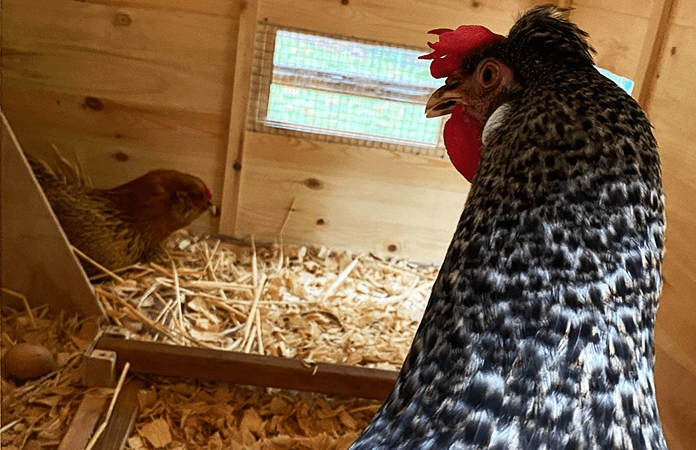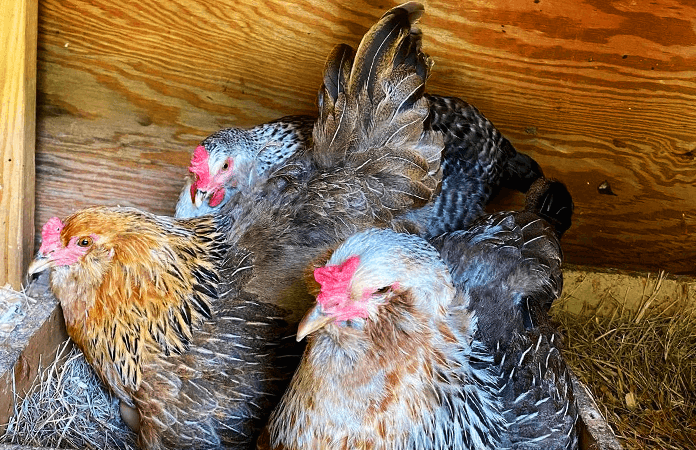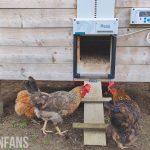How Many Nesting Boxes For 10 Chickens (+ Calculator)

Chickens use their nesting boxes solely to lay eggs. But depending on the breeds you own and the number of chickens, you’ll need enough nesting boxes, so every hen has a secluded place to lay eggs.
Let’s find out how many nesting boxes to provide for a flock of 10 chickens and more.
How many nesting boxes for 10 chickens?
A rule of thumb is to provide one nesting box for every three to four hens. For 10 hens, you’ll need a minimum of 3 to 4 nesting boxes. You have more flexibility for larger flocks and can go for one box for every six chickens.
A good guideline to follow depending on the number of chickens you have:
| Number of chickens (hens) | Amount of nesting boxes |
| 1 – 3 | 1 (preferably 2 if you have the space) |
| 4 | 1 – 2 |
| 5 – 6 | 2 |
| 7 – 8 | 2 – 3 |
| 9 | 3 |
| 10 – 12 | 3 – 4 |
| 13 – 15 | 4 – 5 |
| 16 | 4 – 6 |
| 17 – 18 | 5 – 6 |
| 19 – 20 | 5 -7 |
| 21 | 6 – 7 |
| 22 – 24 | 6 – 8 |
| 25 | 7 – 9 |
| … More | Minimum 10 |
If you want to calculate the amount of inside and outside space to provide for your chickens, including the number of nesting boxes, go to our ‘Coop Size and Nesting Box Calculator’.
Not only does the number of nesting boxes depend on the number of hens you own, but it also depends on the chicken breeds you tend to keep.
Excellent laying hens, like Leghorns, lay up to 300 eggs yearly; that’s 6 eggs per week. They’ll use the nesting boxes on a regular, almost daily base. If you’re keeping a Leghorn flock, it’s better to provide more than enough nesting boxes, at least 4 nesting boxes, when keeping 10 chickens.
Providing at least 4 nesting boxes per 10 chickens is unnecessary if you plan to keep ornamental chickens instead of laying hens. Depending on the breed, they will lay just over once or twice a week.
Best Egg layers:
- Leghorn
- Rhode Island Red
- Australorp
- Plymouth Rock
- Isa Brown
popular ornamental birds (Max 150 eggs yearly):
Does every hen need its own nesting box?
No, providing one nesting box for each individual hen in your flock is unnecessary. You’ll notice that they don’t lay simultaneously; most nesting boxes will stay empty during the day. All hens will have their preferable nesting box; it’s not uncommon for two or three hens to crawl into the same nesting box.

Noticing three hens in the same nesting box does not mean you’ll have to install more. They just love that particular box. If you install additional nesting boxes, they’ll probably stay empty while your hens keep cramming into one box rather than choosing one that’s available.
What size should a nesting box be?
The most followed guideline is 12″x12″x12″ inch for medium-sized chickens, but when planning to keep various breeds, including bigger ones, a guideline of 14″x14″x14″ is better to keep in mind. Larger breeds need bigger nesting boxes, especially in height.
Small chicken breeds, like bantams or Silkies, can have smaller boxes and 12″x12″x12″ will suffice, but large breeds, like Brahmas or Jersey Giants, need bigger nesting boxes, especially in height.
Best Bedding in a Nesting Box
When it comes to creating a safe and cozy space for your chickens to lay their eggs, selecting the right bedding is of utmost importance. The bedding inside the nesting box should be soft, cushioned, and absorbent to reduce the risk of egg breakage and maintain a clean environment.
Nesting boxes have multiple bedding options, including nesting box pads, straw, hemp, and wood shavings. To learn more about the different bedding options and find the best one for your chickens, read our comprehensive article: “Best Bedding for a Nesting Box“.
Or go to our brand-specific reviews: ‘Eaton Pet and Pasture Nesting Pads: Review‘ and ‘My Favorite Chicken Aromatic Nest Pads: Review‘.
Summary
A rule of thumb is to provide one nesting box for every three to four hens. For 10 hens, you’ll need a minimum of 3 to 4 nesting boxes. Not only does the number of nesting boxes depend on the number of hens you own, but it also depends on the chicken breeds you tend to keep.
Providing one nesting box for each individual hen in your flock is unnecessary. You’ll notice that they don’t lay simultaneously; most nesting boxes will stay empty during the day.
Credits Featured Image: @sylvia0223 (IG)






















